A Walk Down Al Moez Ldin Allah Al Fatmi Street: A Must-Do for Any Visitor to Cairo
As a city founded in 969 AD, Cairo has a rich history. And one of the best ways to delve into its past and appreciate its medieval Islamic architecture and art is to walk down Al Moez Ldin Allah Al Fatmi Street. This free pedestrian street is a must-see for any visitor to Cairo, offering a glimpse into the remnants of the pre-Cairo cities, including the famous mosques, madrasas, hammams, and fountains. Whether you're a history buff or simply someone who appreciates stunning architecture, a stroll down Al Moez Ldin Allah Al Fatmi Street is an experience you won't miss.

Importance of experiencing Al Moez Ldin Allah Al Fatmi Street
If you're a history enthusiast or just looking for a unique cultural experience, Al Moez Ldin Allah Al Fatmi Street should be on your list of must-visit places in Cairo. This beautifully preserved street showcases Islamic architecture, art, and history that dates back centuries. Walking down the street, you'll feel like you're stepping back in time as you take in the medieval buildings on one side and modern-day vendors on the other. This mix of old and new adds to the charm of the street and makes it a one-of-a-kind experience.
Al Moez Ldin Allah Al Fatmi Street held great significance in the history of Cairo and was named after its founder in 1937. The street reflects the city's rich history and cultural heritage. As you wander around, you'll discover the diverse influences of the various Islamic dynasties that ruled over Cairo. The street also boasts UNESCO World Heritage Site status, which proves its historical importance.
Aside from its historical significance, Al Moez Ldin Allah Al Fatmi Street is located near other famous landmarks, such as Khan el-Khalili, making it easily accessible to visitors. The street is open during working hours and is easily accessible to tourists who want to experience the rich history and culture of Cairo.
Visitors can enter the street through two ancient gates, Bab El Fotouh and Bab El Nasr, which are stunning architectural feats. Additionally, no visit to the street is complete without visiting the Al-Hakim Mosque, a major attraction with great religious significance.
Visiting Al Moez Ldin Allah Al Fatmi Street is an experience that cannot be missed. It's a must-visit for anyone who wants to explore Cairo's rich history and culture while immersing themselves in an atmosphere of ancient charm and modern vibrancy. [1][2]

A brief overview of the street's history and significance
Located in Old Cairo, Al Moez Ldin Allah Al Fatmi Street is a must-visit destination for anyone touring the city. This historical street stretches from the northern gates of Cairo's Old City walls to the south. As one of Cairo's oldest and most significant areas, it has significantly shaped the city's history and development.
Founded in 969 AD by the Fatimids, a North African Shi'ite Muslim caliphate, the area of Old Cairo has been home to numerous Islamic dynasties throughout the centuries. Today, it showcases a blend of medieval and modern buildings and vendors, creating a unique and captivating atmosphere. Al Moez Ldin Allah Al Fatmi Street is not just a pedestrian zone but a UNESCO World Heritage Site since 1979.
The street is recognized for its famous mosques, madrasas, hammams, and fountains. When walking down this street, visitors will witness a mix of medieval buildings, modern shops, and vendors selling everything from food to souvenirs. Moreover, Al Moez Ldin Allah Al Fatmi Street is conveniently located near other well-known landmarks, including Khan el-Khalili, and is easily accessible during public visiting hours. [3][4]

Historical Background of Cairo and Old Cairo
Cairo, a city steeped in rich history and culture, showcases its traces of various Islamic dynasties through its architecture and society today. Founded in 969 AD by the Fatimids – a North African Shi'ite Muslim caliphate – the city has seen several Islamic leaders leave their imprints.
Old Cairo, also known as Historic Cairo, is an area that encompasses remnants of the pre-Cairo cities of Fustat, Al-Askar, and Al-Qatta'i, in addition to Coptic Cairo and Islamic Cairo. The Islamic portion of Old Cairo is home to Al Moez Ldin Allah Al Fatmi Street, a thoroughfare named after the 4th caliph of the Fatimid dynasty.
The street presents a mix of medieval and modern buildings and vendors, showcasing the city's intriguing juxtaposition of old and new. In 1979, Old Cairo was recognized as a UNESCO World Heritage Site, highlighting its significance as one of the world's oldest Islamic cities. This esteemed designation honours Old Cairo's famous mosques, madrasas, hammams, and fountains.
Exploring the history and cultural richness of Cairo is essential for any visitor to the city. In particular, a visit to Al Moez Ldin Allah Al Fatmi Street is a must for those wanting to experience the true essence of Islamic Cairo. [5][6]
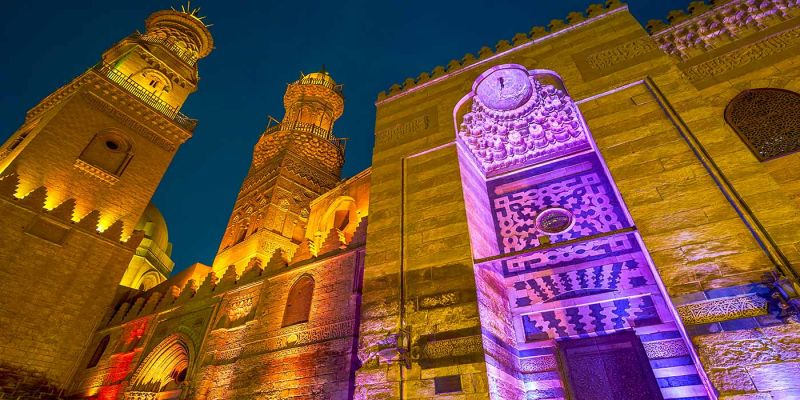
Islamic dynasties and their rule over Cairo
Throughout Cairo's history, the city has been ruled by various Islamic dynasties that have left a significant mark on its architecture and culture. One of the most prominent dynasties that ruled Cairo was the Fatimid Dynasty.
Under the reign of the Fatimid Caliph Al-Moez Ldin Allah Al Fatmi, the city prospered, and many impressive buildings were constructed, such as the Al-Azhar Mosque and the Al-Hakim Mosque. These buildings remain today as a testament to the dynasty's cultural achievements.
Other Islamic dynasties that ruled Cairo include the Ayyubid Dynasty and the Mamluk Sultanate, both known for their grand architectural projects and advancements in art and culture. During the Mamluk period, the city underwent a major transformation by constructing several remarkable buildings, such as the Qalawun Complex and the madrasas, which were learning centres.
These dynasties helped shape the city into the architectural marvel it is today. Visitors to Cairo can experience the city's diverse history and culture by visiting landmarks such as Al-Moez Ldin Allah Al Fatmi Street, where they can witness the stunning architecture and marvel at the impressive buildings constructed during the rule of these Islamic dynasties. [7][8]
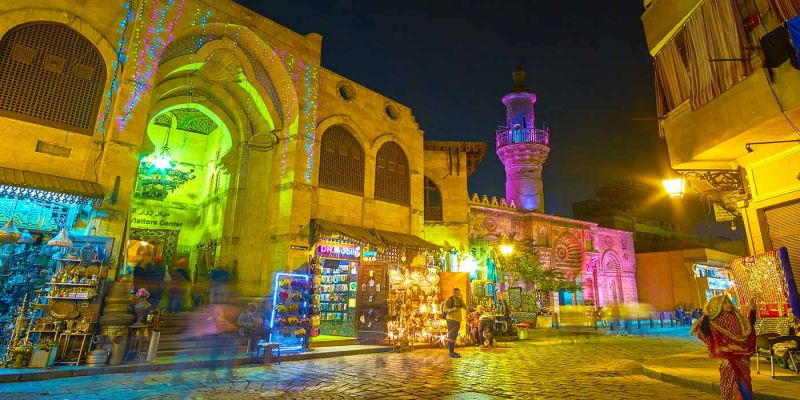
UNESCO recognition of the area as a World Heritage Site
Historic Cairo, celebrated for its renowned mosques, madrasas, hammams, and fountains, was officially designated as a UNESCO World Heritage Site in 1979. Founded in the 10th century, this walled city became the new epicentre of the Islamic world, reaching its golden age in the 14th century. Today, it remains one of the world's oldest Islamic cities and a must-visit destination for anyone captivated by ancient Islamic civilization.
The UNESCO recognition emphasizes the need to preserve this unique city's architectural and cultural heritage. Leading the international community's quest to protect and conserve historic sites, UNESCO acknowledges that places like Historic Cairo are susceptible to uncontrolled urban development, unsustainable tourism practices, neglect, natural disasters, pollution, political instability, and conflict. This recognition also highlights the significance of the city's rich history in Islamic civilization and its contribution to the development of the Muslim world.
A stroll down Al Moez Ldin Allah Al Fatmi Street offers an excellent opportunity to explore the heart of Islamic and historic Cairo and experience firsthand the UNESCO World Heritage Site. [9][10]
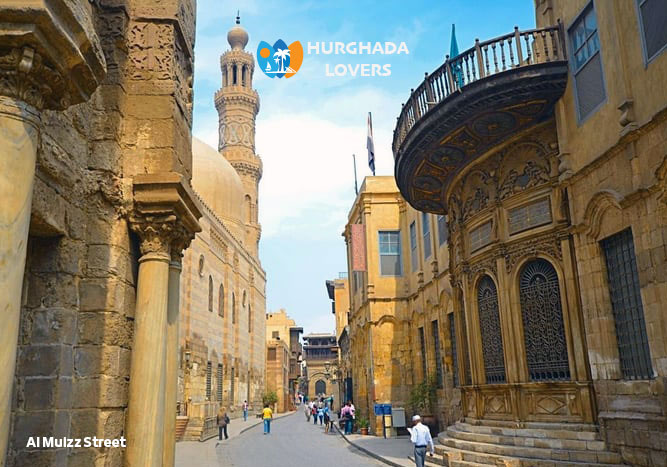
The mix of medieval and modern buildings and vendors
One of the most exciting things about Al Moez Ldin Allah Al Fatmi Street is the mix of medieval and modern buildings and vendors. As you stroll down the street, you'll marvel at the stunning medieval architecture and art juxtaposed with modern vendors selling their wares. It's like taking a trip through time, seeing the history of Cairo come alive before you.
Don't expect a calm stroll through the street, especially as you approach the El Ghouri Complex. The area gets pretty chaotic,, with all the shops and vendors vying for your attention. But that's part of the charm of this street - the energy and vibrant atmosphere.
And,, of course, the location is perfect, with famous landmarks like Khan el-Khalili adjacent. You can explore medieval buildings from the inside; most mosques have free entry. However, some other buildings require a ticket and have working hours.
The mix of old and new on Al Moez Ldin Allah Al Fatmi Street is truly something to behold, and it's a must-see for any visitor to Cairo. [11][12]

Location in relation to other famous landmarks like Khan el-Khalili
Located in the heart of Old Cairo, Al Moez Ldin Allah Al Fatmi Street is a must-do for any visitor to the city. The street runs from the Bab El Fotouh gate in the north to the Bab El Nasr gate in the south, connecting many significant historical landmarks.
One of the most famous landmarks near Al Moez Street is the Khan el-Khalili bazaar, a massive market where visitors can experience the vibrant traditional way of life in Cairo. In addition to the Khan el-Khalili, Al Moez Street is also close to many other notable landmarks, including the Al Azhar Mosque, the Al-Hakim Mosque, and the Beit Al-Suhaymi Museum. Visitors can easily explore these destinations on foot, immersing themselves in the rich culture and history of the region.
While travelling along Al Moez Street, visitors can admire the stunning medieval architecture and browse the various street vendors selling everything from souvenirs to traditional clothing. The area is also easily accessible by car or taxi, and the street is open to visitors from sunrise to sunset every day of the week.
Don't miss the opportunity to experience the cultural and historical significance of Al Moez Ldin Allah Al Fatmi Street on your next visit to Cairo.
Accessibility and working hours
Reaching Al Moez Ldin Allah Al Fatmi Street is a breeze, thanks to its popularity among tourists. To get there, hail a taxi or book an Uber and ask to be dropped off at Bab El Fotouh. This northern entrance to the street is located in Gamaleya, and upon arrival, you can easily stroll through the gate and marvel at the enchanting architecture and lively atmosphere.
One of the best aspects of visiting this captivating street is that there is no entrance fee, and it is accessible 24/7. However, certain medieval structures and palaces along the street require a ticket and follow specific operating hours. While most mosques are free to enter, some historical buildings, such as Beit el Seheimy and the Qalawun Complex, require an admission ticket.
You can purchase either an individual or a combination ticket, which grants you access to various points of interest on Moez Street. This includes historic houses, elegant palaces, and grand mausoleums. The combination ticket is approximately 100 EGP for non-Egyptians and 50 EGP for Egyptians. It is important to remember that these establishments operate between 9 am and 5 pm and remain closed on Sundays.
A visit to Al Moez Ldin Allah Al Fatmi Street offers a perfect opportunity to spend several hours admiring the striking architecture and delving into Cairo's rich history. [15][16]
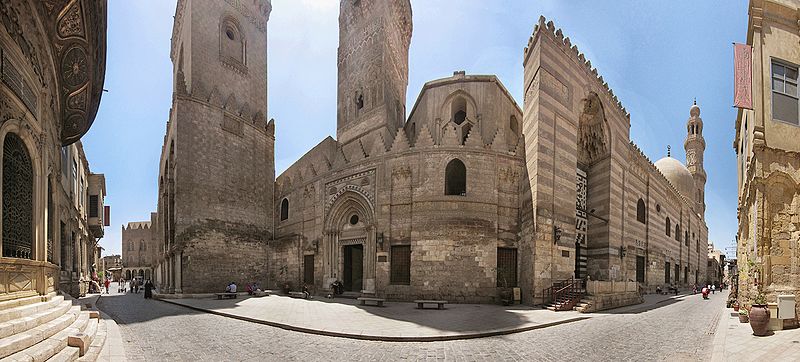
Bab El Fotouh and Bab El Nasr gates
When exploring Al Moez Ldin Allah Al Fatmi Street in Cairo, visitors cannot miss the iconic Bab El Fotouh and Bab El Nasr gates. Bab El Fotouh is the northern gate, while Bab El Nasr is situated at the street's southern end. Both are must-visit landmarks that serve as a gateway to the rich history of Egypt.
These gates were built during the Fatimid period, with Bab El Fotouh completed in 1087 and Bab El Nasr following soon after. The gates are beautiful structures that protect the city from would-be invaders during the war. Today, they are a testament to the country's rich Islamic history and architectural prowess.
It's a sight to behold as visitors walk through these gates and into a world entirely different from the busy and chaotic Cairo streets outside. As you explore Old Cairo, enjoy the intricate designs and details of the gates, from the splayed arch covered in stone-carved patterns to the round towers flanking the entrance.
Bab El Fotouh and Bab El Nasr are two significant buildings that add to the charm and grandeur of Cairo. [17][18]
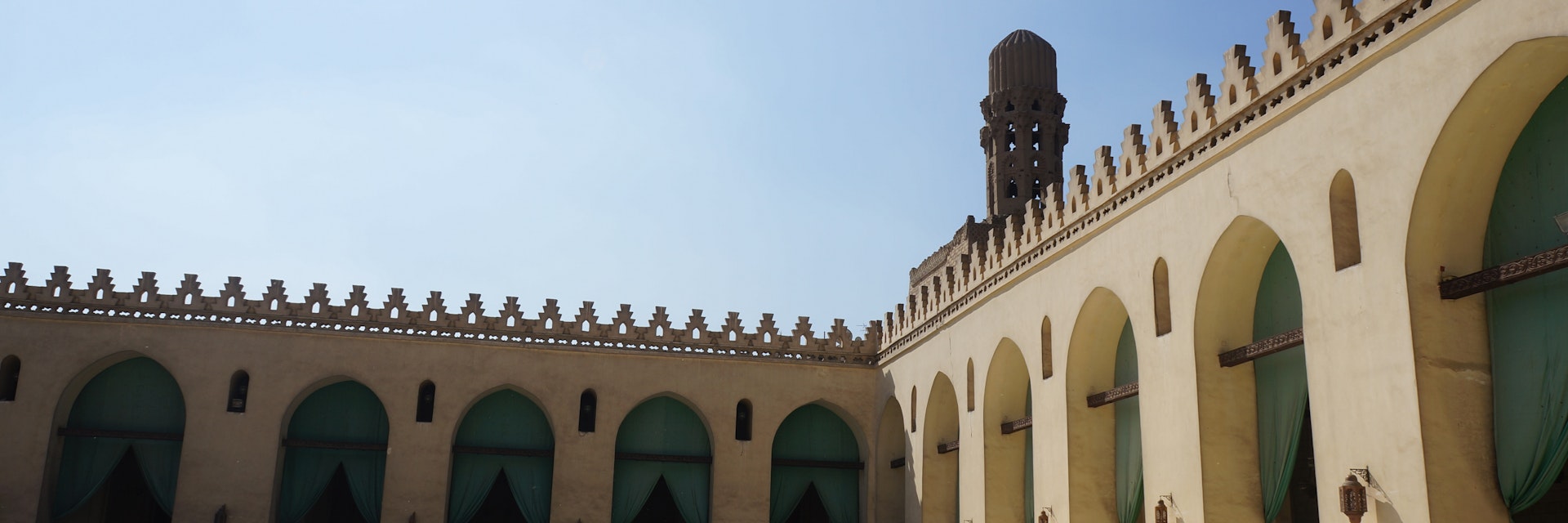
Al-Hakim Mosque
A visit to the Al-Hakim Mosque is an essential experience for any traveller to Cairo. This striking mosque wraps you in its warm embrace, providing comfort, solace, and healing. As soon as you step into its courtyard and behold the well-preserved Fatimid-style architecture, you are instantly transported back in time.
Named after the sixth Fatimid caliph, Al-Hakim bi-Amr Allah, the mosque is a captivating destination to explore during your time in Islamic Cairo. Although Al-Hakim ruled during a period of persecution against non-Shias, his mosque remains an architectural masterpiece. The aged pillars stand tall and proud, defiant against the passage of time.
One of the highlights of the mosque is its unusual minaret, a marvellous piece of architecture that should not be missed. As you wander through the mosque, you'll gain insights into the early history and culture of Cairo, making it an excellent location for history enthusiasts.
Before entering the mosque, remove your shoes and dress modestly, covering your shoulders and knees. This show of respect will ensure a more enjoyable visit.
The Al-Hakim Mosque stands as a testament to Cairo's rich history and culture, and it is an absolute must-visit for anyone planning to explore Islamic Cairo. [19][20]
